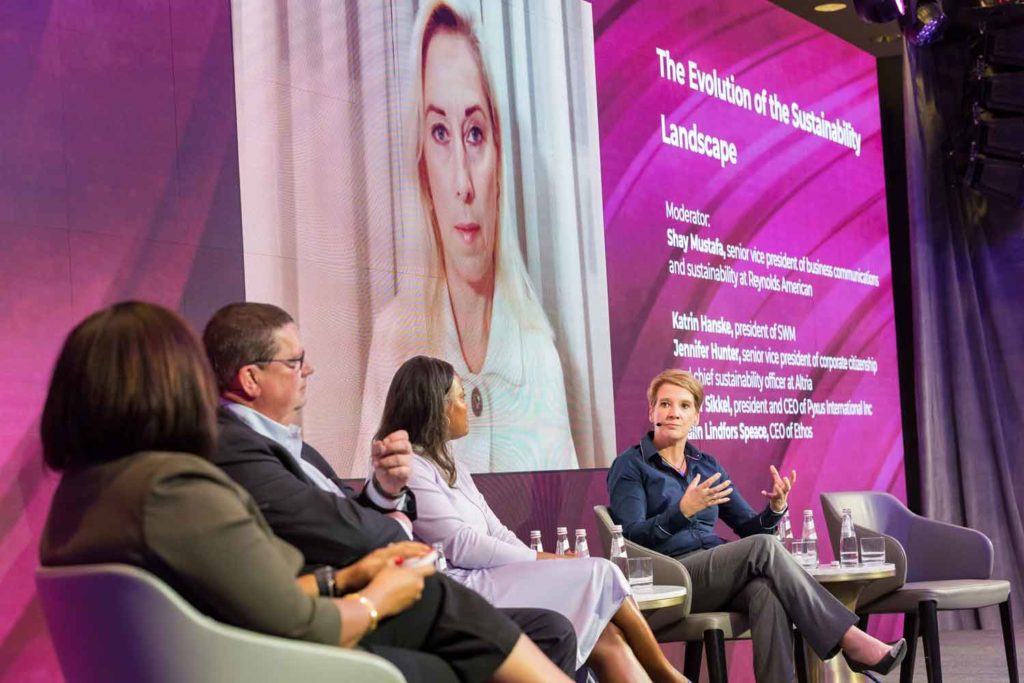The Evolution of Sustainability


Panel Discussion: The Evolution of Sustainability
The “pace of change is accelerating” for environmental, social and governance (ESG) issues, which requires companies to invest in policies and actions that encourage responsible behavior. “ESG is a driver of choice,” a GTNF speaker said.
Due to the nature of its business, tobacco companies can make the greatest ESG gains by reducing the health impact of their products. Moving to a smoke-free future is the single best thing the industry can do in order to maintain its license to operate and create long-term sustainability. “We think that’s right for our consumers,” said a representative of a leading tobacco firm. “We believe it’s right for our employees. We believe it’s right for society broadly.”
Innovation creates value. Sustainability creates value. And those two things are not in conflict, according to one speaker. They are instead reinforcing ideas. Companies cannot innovate alone. They need to innovate alongside their consumer base. The speakers agreed that everyone needs to be involved in innovation with a shared goal of sustainability.
“We believe [one way] we can create positive change is to address the harm of our products. And so that gets more to our vision, which is moving beyond smoking,” a speaker noted, adding that some of the challenges in ESG are knowing what expectations are, especially from consumers and shareholders. “You take the time to understand what they expect, you identify where are the areas of your business where you can align those expectations into your business practices and then measure and communicate the progress that you’re making.”
ESG used to exist on an island. Today, it’s a core part of how leadership drives the long-term success of a business. The speakers noted that changes brought about through ESG initiatives will determine the long-term success of companies. A company must address its “most pressing issues” that stakeholders care about.
“We talk about transforming people’s lives so that together we can grow better. It’s frankly something that all our employees around the world can really get behind. But it’s not just the talk; it’s the walk, right?” a speaker asked. “It’s measuring what you have and setting real targets of what we want to achieve and reporting on those in a very public way. I think this industry is way too shy about talking about some of the positive achievements that it’s had and it’s made and continues to make around the globe.”
The best practice is to intertwine sustainability and business strategies—where the board and the executive team are acting as the coaches of the company’s sustainability goals. “It is about being standardized, being transparent, basing your numbers on actual science and facts, and being [able to implement these policies throughout] the full value chain,” one speaker explained. “One of the key takeaways is that perhaps ESG/sustainability efforts at some point were seen as optional. But the reality is that this is not the case now. It is no longer optional. And I think we’re all committed to trying to do the right thing.”
ESG can be driven by governmental regulation too. Those regulations can become game changers for companies, according to several speakers. For example, the European Union has launched the “European Standards for Sustainability Report.” The report essentially outlines what companies have done over the past 20 years to move toward a more sustainable future. The report also shows that ESG isn’t easy. It also offers a potential blueprint for companies struggling for innovative sustainability ideas.
“[The meaning of] ultimate sustainability is really sort of combatting climate change and decreasing emissions, saving water … minimizing pollution and waste, looking at diversity and quantity, having zero corruption, looking at almost everything from tax clarity to human rights and supply chains,” one speaker said. “It’s a lot of work and you don’t want to invest in that work if you’re not going to get the value to actually build a more successful, sustainable company.”
In the end, sustainability, ESG and tobacco harm reduction go hand in hand. One speaker explained it as a three-legged stool. When you think about the products themselves, you have to have products that are satisfactory to the adult tobacco consumer. It’s a product that’s going to be commercially successful. Consumers will enjoy it, and they will transition to authorized smoke-free products.
“We also know that there are consumers who want to entirely quit using tobacco products, and so we think supporting adult tobacco consumers who have made the decision to quit [and are] able to do so successfully is also an important element of harm reduction.”
“And then we absolutely have to make sure that underage use is not an issue,” one speaker explained. “We’ve heard the conversation about innovative reduced-risk products cannot be an offramp for the adult tobacco consumer and an on-ramp for youth, and so there has to continue to be a lot of attention to those three pillars of the stool to make sure that underage use [is limited], especially as we start thinking about new-to-market products.”
